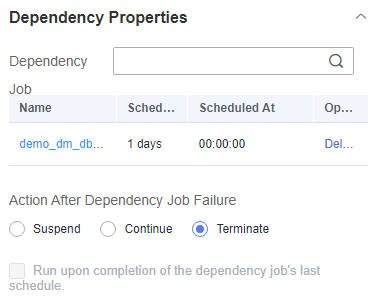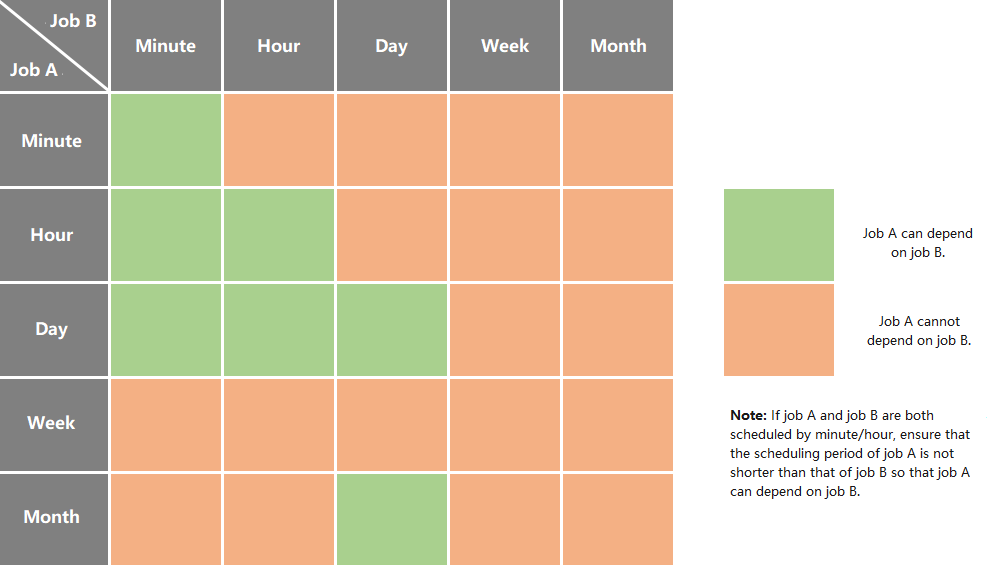Job Dependency¶
You can set a job that meets the scheduling period conditions as the dependency jobs for a job that is scheduled periodically. For details about how to set a dependency job, see DataArts Factory > Job Development > Setting Up Scheduling for a Job in DataArts Studio User Guide.
For example, you can set a dependency job (job B) for job A which is scheduled periodically. In this case, job A will be executed only when all the instances of job B are executed successfully within a specified period.
Note
The specified period is calculated as follows (see How a Job Runs After a Dependency Job Is Set for It for details):
Same-cycle dependency: If the scheduling periods of the two jobs are accurate to the same level (for example, minute, hour, or day), the specified period is (Execution time of job A - Recurrence of job A, Execution time of job A].
Cross-cycle dependency: If the scheduling periods of the two jobs are accurate to different levels, the specified period is [Natural start time of the previous recurrence of job A, Natural start time of the current recurrence of job A).
Parameter Policy for Current job If Dependency job Fails determines whether job A will check the status of job B's instances.
If this parameter is set to Suspend or Terminate, job A will be suspended or terminated if instances of job B fail during a specified time period.
If this parameter is set to Continue, job A will be executed only if all the instances of job B are executed (regardless of whether the execution is successful or not).

Figure 1 Job dependency attributes¶
This section describes how to set the conditions of a dependency job and how a job runs after a dependency job is set for it.
Setting Conditions of a Dependency Job¶
The recurrence of a periodically scheduled job can be minute, hour, day, week, or month. If job A and job B are both periodically scheduled jobs, and you want to set job B as the dependency job of job A, their recurrences must meet the following requirements:
The recurrence of job A cannot be shorter than that of job B. For example, if both job A and job B are scheduled by minute or hour and the interval of job A is shorter than that of job B, then job B cannot be set as the dependency job of job A. If job A is scheduled by minute and job B is scheduled by hour, job B cannot be set as the dependency job of job A.
The recurrence of neither job A nor job B can be week. For example, if the recurrence of job A or job B is week, job B cannot be set as the dependency job of job A.
A job whose recurrence is month can depend only on a job whose recurrence is day. For example, if the recurrence of job A is month, job B can be set as the dependency job of job A only if job B's recurrence is day.
Figure 2 shows the requirements of the recurrences of the jobs that can function as the dependency jobs of other jobs

Figure 2 Job dependency¶
How a Job Runs After a Dependency Job Is Set for It¶
It varies depending on whether a job and its dependency job has the same recurrence. In this example, assume that the Policy for Current job If Dependency job Fails parameter is set to Continue, and job A does not check the running statuses of job B's instances. If this parameter is set to Suspend or Terminate, job A will also check whether there are failed instances in job B.
Same-cycle dependency: Job A and its dependency job B have the same recurrence, for example, minute, hour, or day.
After job B is set as the dependency job of job A, job A checks whether instances of job B are running within a specified time range (Execution time of job A - Recurrence of job A, Execution time of job A). Job A will be executed only if all the instances of job B are executed.
Example 1: Job A depends on job B and they are both scheduled by minute. Job A starts at 10:00 and the interval is 20 minutes. Job B starts at 10:00 and the interval is 10 minutes. The following table lists how the two jobs run.
Table 1 Example 1: dependency between jobs with the same recurrence¶ Time Point
Job B (Starting at 10:00 and Scheduled Every 10 Minutes)
Job A (Starting at 10:00 and Scheduled Every 20 Minutes)
10:00
Executed
Executed after job B's instances are executed in the (09:40, 10:00] time period
10:10
Executed
-10:20
Executed
Executed after job B's instances are executed in the (10:00, 10:20] time period
10:30
Executed
-...
...
...
Example 2: Job A depends on job B and they are both scheduled by day. Job A starts at 09:00 on August 1, and job B starts at 10:00 on August 1. The following table lists how the two jobs run.
Table 2 Example 2: dependency between jobs with the same recurrence¶ Time Point
Job B (Starting at 10:00 on August 1 and Scheduled by Day)
Job A (Starting at 09:00 on August 1 and Scheduled by Day)
09:00 on August 1
-Not executed if no instance of job B is running in the (09:00 on July 31, 09:00 on August 1] time period
10:00 on August 1
Executed
-09:00 on August 2
-Executed after job B's instances are executed in the (09:00 on August 1, 09:00 on August 2] time period
10:00 on August 2
Executed
-...
...
...
Cross-cycle dependency: Job A and its dependency job B have different recurrences.
After job B is set as the dependent job of job A, job A checks whether any instance of job B is running in the time range (Natural start time of the previous recurrence of job A, Natural start time of the current recurrence of job A). Job A will be executed only after all the instances of job B are executed.
Note
The natural start time of a recurrence is defined as follows:
If the recurrence is hour, the natural start time of the previous recurrence is 00:00 of the previous hour, and the natural start time of the current recurrence is 00:00 of the current hour.
If the recurrence is day, the natural start time of the previous recurrence is 00:00:00 of the previous day, and the natural start time of the current recurrence is 00:00:00 of the current day.
If the recurrence is month, the natural start time of the previous recurrence is 00:00:00 on 1st of the previous month, and the natural start time of the current recurrence is 00:00:00 on 1st of the current month.
Example 3: Job A depends on job B. Job A is scheduled by day, and job B is scheduled by hour. Job A is executed at 02:00 every day. Job B starts at 00:00 and is executed at an interval of 10 hours. The following table lists how the two jobs run.
Table 3 Example 3: dependency between jobs with different recurrences¶ Time Point
Job B (Starting at 00:00 at an Interval of 10 hours and Scheduled by Hour)
Job A (Scheduled at 02:00 Every Day)
00:00 on the first day
Executed
-02:00 on the first day
-Not executed if no instance of job B is running in the [00:00:00 on day 0, 00:00:00 on day 1) time period
10:00 on the first day
Executed
-20:00 on the first day
Executed
-00:00 on the second day
Executed
-02:00 on the second day
-Executed if instances of job B are executed in the [00:00:00 on day 1, 00:00:00 on day 2) time period
10:00 on the second day
Executed
-20:00 on the second day
Executed
-...
...
...
Example 4: Job A depends on job B. Job A is scheduled by month, and job B is scheduled by day. Job A is executed at 02:00 on the first and second days of each month. Job B is executed at 00:00 on August 1. The following table lists how the two jobs run.
Table 4 Example 4: dependency between jobs with different recurrences¶ Time Point
Job B (Scheduled by Day and Executed at 00:00 on August 1)
Job A (Scheduled by Month and Executed at 02:00 on the First and Second Days of Each Month)
00:00 on August 1
Executed
-02:00 on August 1
-Not executed if no instance of job B is running in the [00:00:00 on July 1, 00:00:00 on August 1) time period
00:00 on August 2
Executed
-02:00 on August 2
-Not executed if no instance of job B is running in the [00:00:00 on July 1, 00:00:00 on August 1) time period
...
-...
00:00 on September 1
Executed
-02:00 on September 1
-Executed if instances of job B are executed in the [00:00:00 on August 1, 00:00:00 on September 1) time period
00:00 on September 2
Executed
-02:00 on September 2
-Executed if instances of job B are executed in the [00:00:00 on August 1, 00:00:00 on September 1) time period
...
...
...